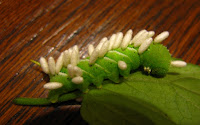 |
| Caterpillar with parasitoid coccoons By Jesse Noar CC BY 4.0 |
This episode: A virus partners with a parasitoid wasp to help exploit fruit fly victims!
Download Episode (7.7 MB, 11.2 minutes)
Show notes:
Microbe of the episode: Actinomadura livida
Takeaways
Parasitoid wasps have an interesting lifestyle: they inject their eggs into the larvae of other insects, and their young hatch and grow up by consuming the host from the inside. Some of these wasps also inject a virus along with the egg, which supports the wasp offspring by suppressing the host immune system.
Most of these parasitoid helper viruses are integrated into the host wasp genome and are translated and produced as needed, but in this study, an independently replicating entomopoxvirus serves as an example of a virus-wasp mutualism. The study explores how the virus can infect the wasp prey, and how it gets passed on to wasp offspring.
Most of these parasitoid helper viruses are integrated into the host wasp genome and are translated and produced as needed, but in this study, an independently replicating entomopoxvirus serves as an example of a virus-wasp mutualism. The study explores how the virus can infect the wasp prey, and how it gets passed on to wasp offspring.
Journal Paper:
Coffman KA, Hankinson QM, Burke GR. 2022. A viral mutualist employs posthatch transmission for vertical and horizontal spread among parasitoid wasps. Proc Natl Acad Sci 119:e2120048119.
Post questions or comments here or email to bacteriofiles@gmail.com. Thanks for listening!
Subscribe: Apple Podcasts, Google Podcasts, Android, or RSS. Support the show at Patreon, or check out the show at Twitter or Facebook.




